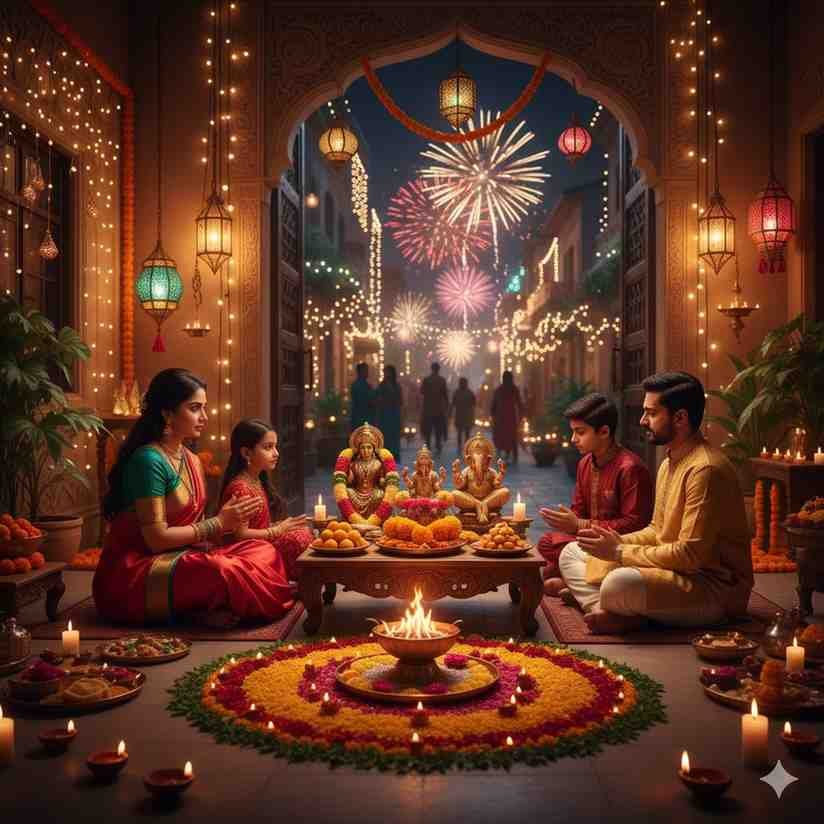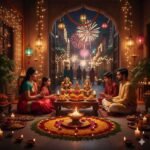
Deepavali: Symbolism, Lakshmi Puja, and the Triumph of Ligh
Diwali, also known as Deepavali, is one of the most significant and widely celebrated festivals in India and around the world. Known as the “Festival of Lights,” it is a five-day celebration that symbolizes the spiritual victory of light over darkness, good over evil, and knowledge over ignorance.
1. Significance and Symbolism
The core meaning of Diwali revolves around illumination, both external (lighting lamps) and internal (gaining wisdom). It is celebrated for various reasons across different traditions, but the central theme remains the same: the triumph of righteousness.
- Triumph of Good Over Evil: In North India, Diwali is primarily celebrated to commemorate the return of Lord Rama to Ayodhya after a 14-year exile, having defeated the demon king Ravana. The people of Ayodhya welcomed him by lighting countless earthen lamps (diyas).
- Worship of Prosperity and Wisdom: The main day of Diwali is dedicated to the worship of Goddess Lakshmi, the deity of wealth and prosperity, and Lord Ganesha, the god of wisdom and the remover of obstacles. People clean and decorate their homes, believing that Goddess Lakshmi visits the cleanest house to bestow her blessings for the coming year.
- Jainism and Sikhism: Jains celebrate Diwali to mark the final liberation (moksha) of Lord Mahavira. Sikhs observe the day as Bandi Chhor Divas (Day of Liberation), commemorating the release of their sixth Guru, Guru Hargobind, from a Mughal prison.
2. When is Diwali Celebrated?
Diwali is celebrated according to the Hindu lunar calendar, during the darkest night of the month of Kartik (the new moon day, or Amavasya). The date typically falls between mid-October and mid-November.
For 2025 (as per current astrological calendars):
| Day | Date (2025) | Festival Name | Significance |
| Day 1 | October 18, Saturday | Dhanteras | Auspicious day to purchase new metal items (gold, silver, or utensils) to symbolize the welcoming of wealth and to worship Goddess Lakshmi and Lord Dhanvantari. |
| Day 2 | October 19, Sunday | Naraka Chaturdashi (Choti Diwali) | Celebrates Lord Krishna’s victory over the demon Narakasura. Marked by ritual oil baths before sunrise and lighting of the first diyas. |
| Day 3 | October 20, Monday | Diwali (Main Day) / Lakshmi Puja | The main day of celebration. Families perform Lakshmi-Ganesha Puja during the auspicious Pradosh Kaal (dusk) and illuminate their homes with lamps. |
| Day 4 | October 22, Wednesday | Govardhan Puja | Celebrates Lord Krishna’s act of lifting the Govardhan Hill to protect the villagers. Devotees often prepare and offer a mountain of food (Annakut) to the deities. |
| Day 5 | October 23, Thursday | Bhai Dooj | Celebrates the sacred bond between brothers and sisters. Sisters perform a tilak ceremony for their brothers’ well-being and long life, and gifts are exchanged. |
(Note: The main Diwali date can sometimes shift by a day depending on the end time of the Amavasya tithi in different regions.)
3. Key Traditions and Customs
Diwali is characterized by a set of vibrant and beautiful customs:
- Lighting Diyas and Candles: The most central ritual is illuminating homes, temples, and streets with earthen oil lamps (diyas), candles, and electric lights to ward off darkness and symbolize hope.
- Cleaning and Decoration: Homes are thoroughly cleaned, painted, and decorated with flowers, lanterns, and colorful intricate floor patterns called Rangoli to welcome the deities and positive energy.
- Puja (Worship): Families gather in the evening for the Lakshmi Puja, where prayers are offered to the gods for prosperity, health, and a successful year ahead.
- Feasting and Sweets: The festival is incomplete without a massive spread of homemade traditional sweets (mithai) and savory snacks (farsan). These delicacies are generously shared with friends, neighbors, and relatives.
- Exchanging Gifts: The giving of gifts, sweets, and new clothes is a key tradition that strengthens familial and social bonds.
- Fireworks: In many regions, the evening is celebrated with magnificent fireworks, though there is a growing awareness and movement towards eco-friendly altern
For more artcles click here
- How to Download Your Telangana Family Member Certificate Soft Copy (FMC)
- Top 5 Indian Cities to Buy Property in 2025: Investment & Growth Guide
- 100+ Unique Anniversary Wishes for Everyone You Know
- Top 15 Best Indian Social Media & AI Apps (2025): Revolutionizing Bharat’s Digital Future
- 1000+ Happy Birthday Wishes for Everyone in Your Life









